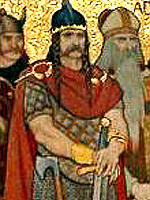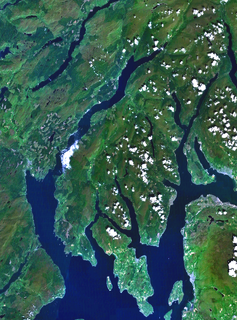Conall mac Áedáin was a king in Scotland in the years around 800. It is thought that he was a king, or sub-king, in Dál Riata.

Scotland is a country that is part of the United Kingdom. Sharing a border with England to the southeast, Scotland is otherwise surrounded by the Atlantic Ocean to the north and west, by the North Sea to the northeast and by the Irish Sea to the south. In addition to the mainland, situated on the northern third of the island of Great Britain, Scotland has over 790 islands, including the Northern Isles and the Hebrides.

Dál Riata or Dál Riada was a Gaelic overkingdom that included parts of western Scotland and northeastern Ireland, on each side of the North Channel. At its height in the late 6th and early 7th centuries, it encompassed roughly what is now Argyll in Scotland and part of County Antrim in the Irish province of Ulster.
He is mentioned once in the Annals of Ulster, for 807, when he defeated and killed Conall mac Taidg in Kintyre.

The Annals of Ulster are annals of medieval Ireland. The entries span the years from A.D. 431 to A.D. 1540. The entries up to A.D. 1489 were compiled in the late 15th century by the scribe Ruaidhrí Ó Luinín, under his patron Cathal Óg Mac Maghnusa on the island of Belle Isle on Lough Erne in the kingdom of Fermanagh. Later entries were added by others.
Conall mac Taidg was a king of the Picts from 785 until 789. Very little is recorded of Conall. He is mentioned twice by the Irish annals, the most reliable source for the history of northern Britain in the years around 800. He also appears in later king lists.

Kintyre is a peninsula in western Scotland, in the southwest of Argyll and Bute. The peninsula stretches about 30 miles (48 km), from the Mull of Kintyre in the south to East Loch Tarbert in the north. The area immediately north of Kintyre is known as Knapdale.
Conall is thought to be mentioned in the Duan Albanach: "The two years of Conall of glorious career, And the four of another Conall." The first is presumed to be Conall mac Taidg, the second Conall mac Áedáin. His reign is therefore reconstructed as beginning in 807 and ending in about 811.

The Duan Albanach is a Middle Gaelic poem found with the Lebor Bretnach, a Gaelic version of the Historia Brittonum of Nennius, with extensive additional material.
He is thought to have been followed by Domnall mac Caustantín.
Domnall mac Caustantín is thought to have been king of Dál Riata in the early ninth century.



